Project Governance and Responsibilities in Construction Projects
VerifiedAdded on 2023/03/31
|24
|4726
|389
Report
AI Summary
This report provides a comprehensive overview of project governance within the construction industry, tailored for capital-intensive organizations. It outlines the meaning of project governance, recommends a robust governance structure including establishing accountability, appointing stakeholders, and implementing effective systems, while emphasizing regular monitoring and maintaining project focus. The report details the responsibilities of key individuals such as owners, architects, facility managers, health and safety inspectors, and construction workers. It also explores critical project phases: initiation, planning, execution, and closure, highlighting the importance of each phase in ensuring project success. The document concludes by discussing the role and operation of the project steering committee, offering insights into its terms of reference and operational procedures. This resource is designed to guide construction companies in establishing and maintaining effective project governance practices to mitigate risks, optimize resource utilization, and ensure successful project delivery.

PROJECT GOVERNANCE 1
Project governance
Institution
Student name
Date
Project governance
Institution
Student name
Date
Paraphrase This Document
Need a fresh take? Get an instant paraphrase of this document with our AI Paraphraser

PROJECT GOVERNANCE 2
Executive summary
This article is written with an objective of delivering a report to the chief executive
officer and the board of governance on the information necessary for installing effective project
governance and the responsibility assigned to the individuals of the organization as well as the
project life cycle.
The report herein focuses on the governance of the project. The information and data
used are dedicated to a construction company that is capital intensive; hence, the assumptions
made are specific to the organization, thus limiting the report from the universal application.
Executive summary
This article is written with an objective of delivering a report to the chief executive
officer and the board of governance on the information necessary for installing effective project
governance and the responsibility assigned to the individuals of the organization as well as the
project life cycle.
The report herein focuses on the governance of the project. The information and data
used are dedicated to a construction company that is capital intensive; hence, the assumptions
made are specific to the organization, thus limiting the report from the universal application.

PROJECT GOVERNANCE 3
Table of Contents
Introduction.................................................................................................................................................4
Meaning of project governance..................................................................................................................4
Recommended project governance structure.............................................................................................5
Establish a single accountability point.....................................................................................................6
Appointing stakeholders and working groups.........................................................................................6
Implementing the right system...............................................................................................................6
Regular monitoring..................................................................................................................................7
Maintain the focus on the delivery of the project...................................................................................7
Why the structure.......................................................................................................................................8
Responsibilities of the individuals in the construction project....................................................................8
The owner or the client or the shareholders...........................................................................................8
Architect..................................................................................................................................................8
Facility manager......................................................................................................................................9
Health and safety inspector.....................................................................................................................9
Construction workers..............................................................................................................................9
Project Phases.............................................................................................................................................9
Initiation....................................................................................................................................................10
Planning.....................................................................................................................................................12
Steps in project planning...........................................................................................................................12
Execution phase........................................................................................................................................13
Closure phase............................................................................................................................................14
The project steering committee and operation procedure.......................................................................16
Terms of reference for the project steering committee............................................................................16
Policies and procedure as to how PSC operates........................................................................................17
Conclusion.................................................................................................................................................17
Reference..................................................................................................................................................18
Table of Contents
Introduction.................................................................................................................................................4
Meaning of project governance..................................................................................................................4
Recommended project governance structure.............................................................................................5
Establish a single accountability point.....................................................................................................6
Appointing stakeholders and working groups.........................................................................................6
Implementing the right system...............................................................................................................6
Regular monitoring..................................................................................................................................7
Maintain the focus on the delivery of the project...................................................................................7
Why the structure.......................................................................................................................................8
Responsibilities of the individuals in the construction project....................................................................8
The owner or the client or the shareholders...........................................................................................8
Architect..................................................................................................................................................8
Facility manager......................................................................................................................................9
Health and safety inspector.....................................................................................................................9
Construction workers..............................................................................................................................9
Project Phases.............................................................................................................................................9
Initiation....................................................................................................................................................10
Planning.....................................................................................................................................................12
Steps in project planning...........................................................................................................................12
Execution phase........................................................................................................................................13
Closure phase............................................................................................................................................14
The project steering committee and operation procedure.......................................................................16
Terms of reference for the project steering committee............................................................................16
Policies and procedure as to how PSC operates........................................................................................17
Conclusion.................................................................................................................................................17
Reference..................................................................................................................................................18
⊘ This is a preview!⊘
Do you want full access?
Subscribe today to unlock all pages.

Trusted by 1+ million students worldwide
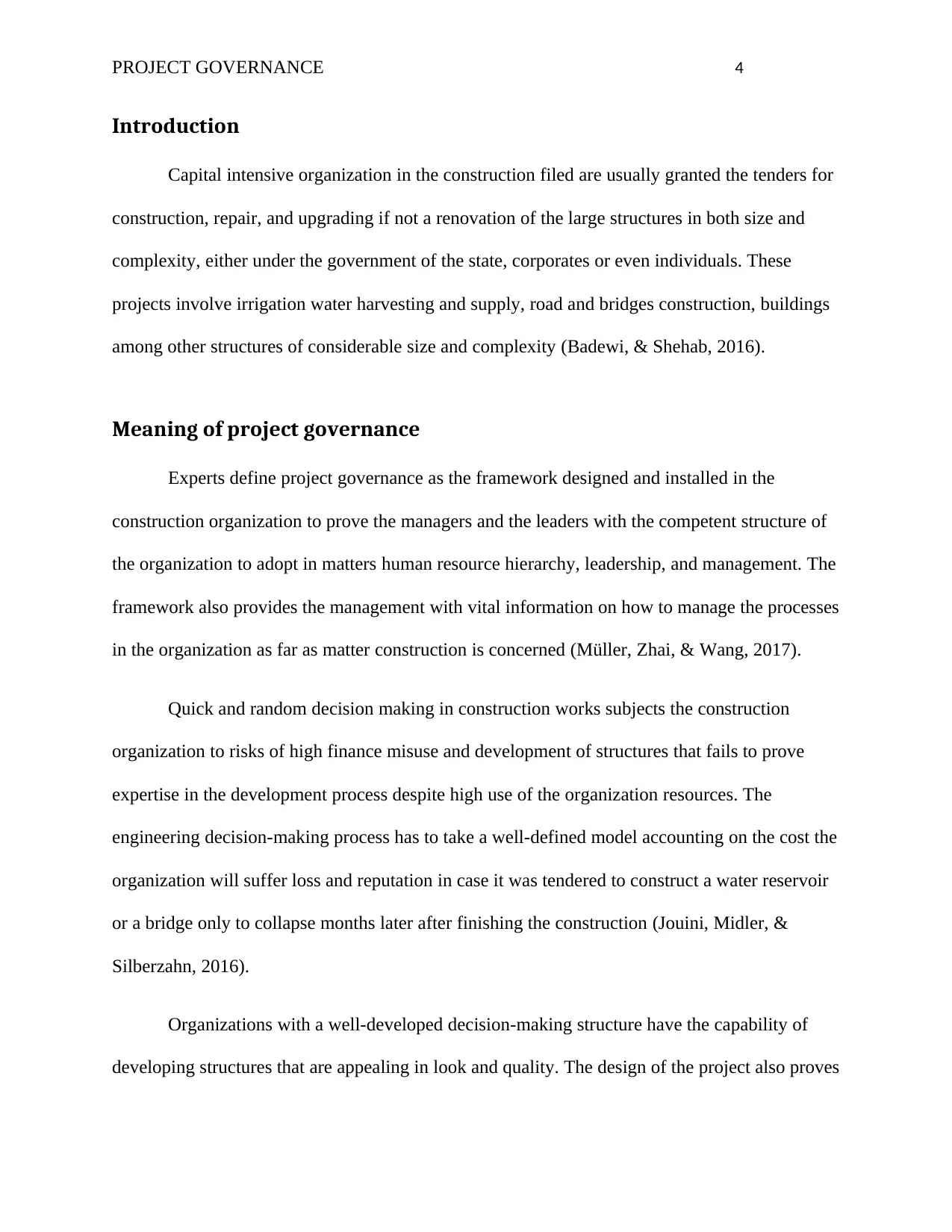
PROJECT GOVERNANCE 4
Introduction
Capital intensive organization in the construction filed are usually granted the tenders for
construction, repair, and upgrading if not a renovation of the large structures in both size and
complexity, either under the government of the state, corporates or even individuals. These
projects involve irrigation water harvesting and supply, road and bridges construction, buildings
among other structures of considerable size and complexity (Badewi, & Shehab, 2016).
Meaning of project governance
Experts define project governance as the framework designed and installed in the
construction organization to prove the managers and the leaders with the competent structure of
the organization to adopt in matters human resource hierarchy, leadership, and management. The
framework also provides the management with vital information on how to manage the processes
in the organization as far as matter construction is concerned (Müller, Zhai, & Wang, 2017).
Quick and random decision making in construction works subjects the construction
organization to risks of high finance misuse and development of structures that fails to prove
expertise in the development process despite high use of the organization resources. The
engineering decision-making process has to take a well-defined model accounting on the cost the
organization will suffer loss and reputation in case it was tendered to construct a water reservoir
or a bridge only to collapse months later after finishing the construction (Jouini, Midler, &
Silberzahn, 2016).
Organizations with a well-developed decision-making structure have the capability of
developing structures that are appealing in look and quality. The design of the project also proves
Introduction
Capital intensive organization in the construction filed are usually granted the tenders for
construction, repair, and upgrading if not a renovation of the large structures in both size and
complexity, either under the government of the state, corporates or even individuals. These
projects involve irrigation water harvesting and supply, road and bridges construction, buildings
among other structures of considerable size and complexity (Badewi, & Shehab, 2016).
Meaning of project governance
Experts define project governance as the framework designed and installed in the
construction organization to prove the managers and the leaders with the competent structure of
the organization to adopt in matters human resource hierarchy, leadership, and management. The
framework also provides the management with vital information on how to manage the processes
in the organization as far as matter construction is concerned (Müller, Zhai, & Wang, 2017).
Quick and random decision making in construction works subjects the construction
organization to risks of high finance misuse and development of structures that fails to prove
expertise in the development process despite high use of the organization resources. The
engineering decision-making process has to take a well-defined model accounting on the cost the
organization will suffer loss and reputation in case it was tendered to construct a water reservoir
or a bridge only to collapse months later after finishing the construction (Jouini, Midler, &
Silberzahn, 2016).
Organizations with a well-developed decision-making structure have the capability of
developing structures that are appealing in look and quality. The design of the project also proves
Paraphrase This Document
Need a fresh take? Get an instant paraphrase of this document with our AI Paraphraser
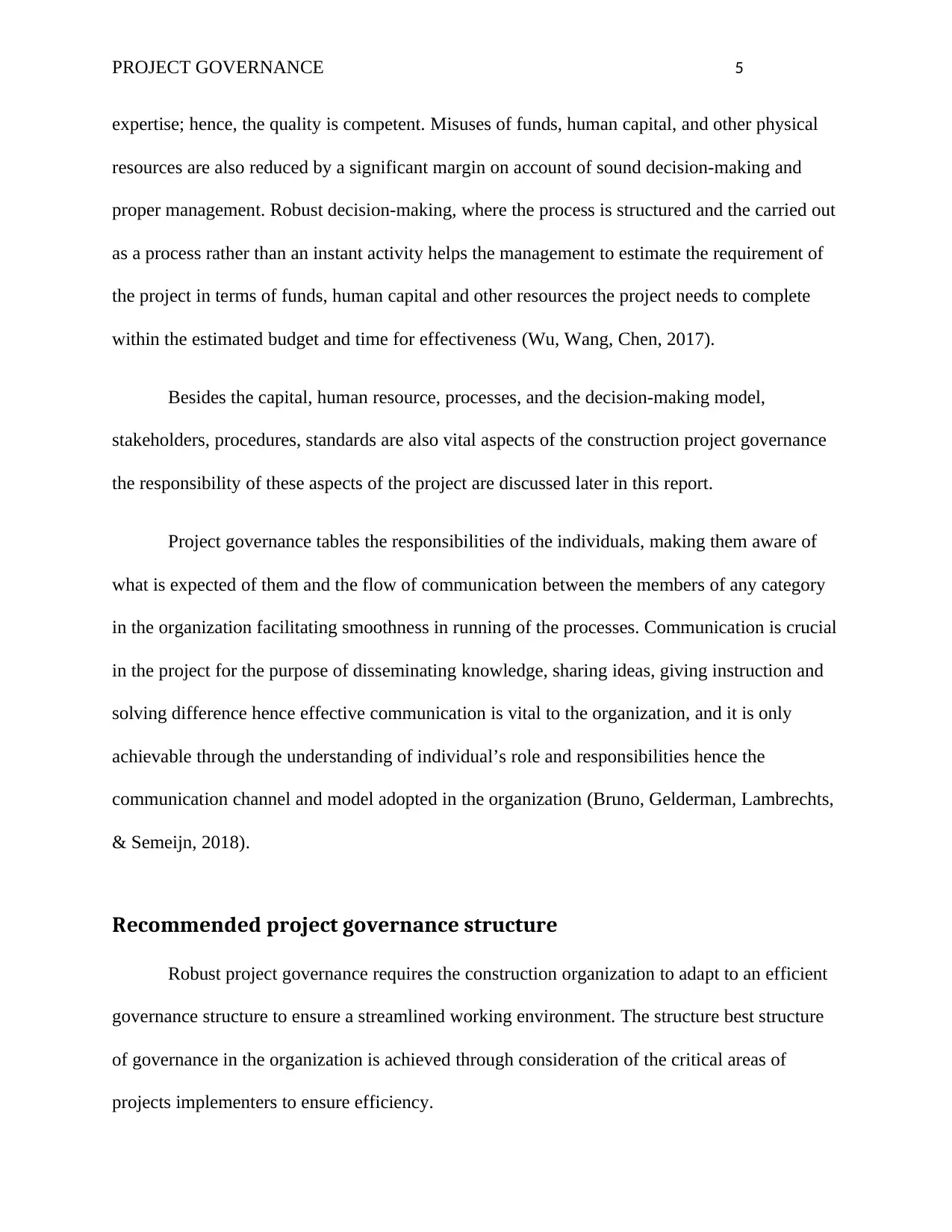
PROJECT GOVERNANCE 5
expertise; hence, the quality is competent. Misuses of funds, human capital, and other physical
resources are also reduced by a significant margin on account of sound decision-making and
proper management. Robust decision-making, where the process is structured and the carried out
as a process rather than an instant activity helps the management to estimate the requirement of
the project in terms of funds, human capital and other resources the project needs to complete
within the estimated budget and time for effectiveness (Wu, Wang, Chen, 2017).
Besides the capital, human resource, processes, and the decision-making model,
stakeholders, procedures, standards are also vital aspects of the construction project governance
the responsibility of these aspects of the project are discussed later in this report.
Project governance tables the responsibilities of the individuals, making them aware of
what is expected of them and the flow of communication between the members of any category
in the organization facilitating smoothness in running of the processes. Communication is crucial
in the project for the purpose of disseminating knowledge, sharing ideas, giving instruction and
solving difference hence effective communication is vital to the organization, and it is only
achievable through the understanding of individual’s role and responsibilities hence the
communication channel and model adopted in the organization (Bruno, Gelderman, Lambrechts,
& Semeijn, 2018).
Recommended project governance structure
Robust project governance requires the construction organization to adapt to an efficient
governance structure to ensure a streamlined working environment. The structure best structure
of governance in the organization is achieved through consideration of the critical areas of
projects implementers to ensure efficiency.
expertise; hence, the quality is competent. Misuses of funds, human capital, and other physical
resources are also reduced by a significant margin on account of sound decision-making and
proper management. Robust decision-making, where the process is structured and the carried out
as a process rather than an instant activity helps the management to estimate the requirement of
the project in terms of funds, human capital and other resources the project needs to complete
within the estimated budget and time for effectiveness (Wu, Wang, Chen, 2017).
Besides the capital, human resource, processes, and the decision-making model,
stakeholders, procedures, standards are also vital aspects of the construction project governance
the responsibility of these aspects of the project are discussed later in this report.
Project governance tables the responsibilities of the individuals, making them aware of
what is expected of them and the flow of communication between the members of any category
in the organization facilitating smoothness in running of the processes. Communication is crucial
in the project for the purpose of disseminating knowledge, sharing ideas, giving instruction and
solving difference hence effective communication is vital to the organization, and it is only
achievable through the understanding of individual’s role and responsibilities hence the
communication channel and model adopted in the organization (Bruno, Gelderman, Lambrechts,
& Semeijn, 2018).
Recommended project governance structure
Robust project governance requires the construction organization to adapt to an efficient
governance structure to ensure a streamlined working environment. The structure best structure
of governance in the organization is achieved through consideration of the critical areas of
projects implementers to ensure efficiency.
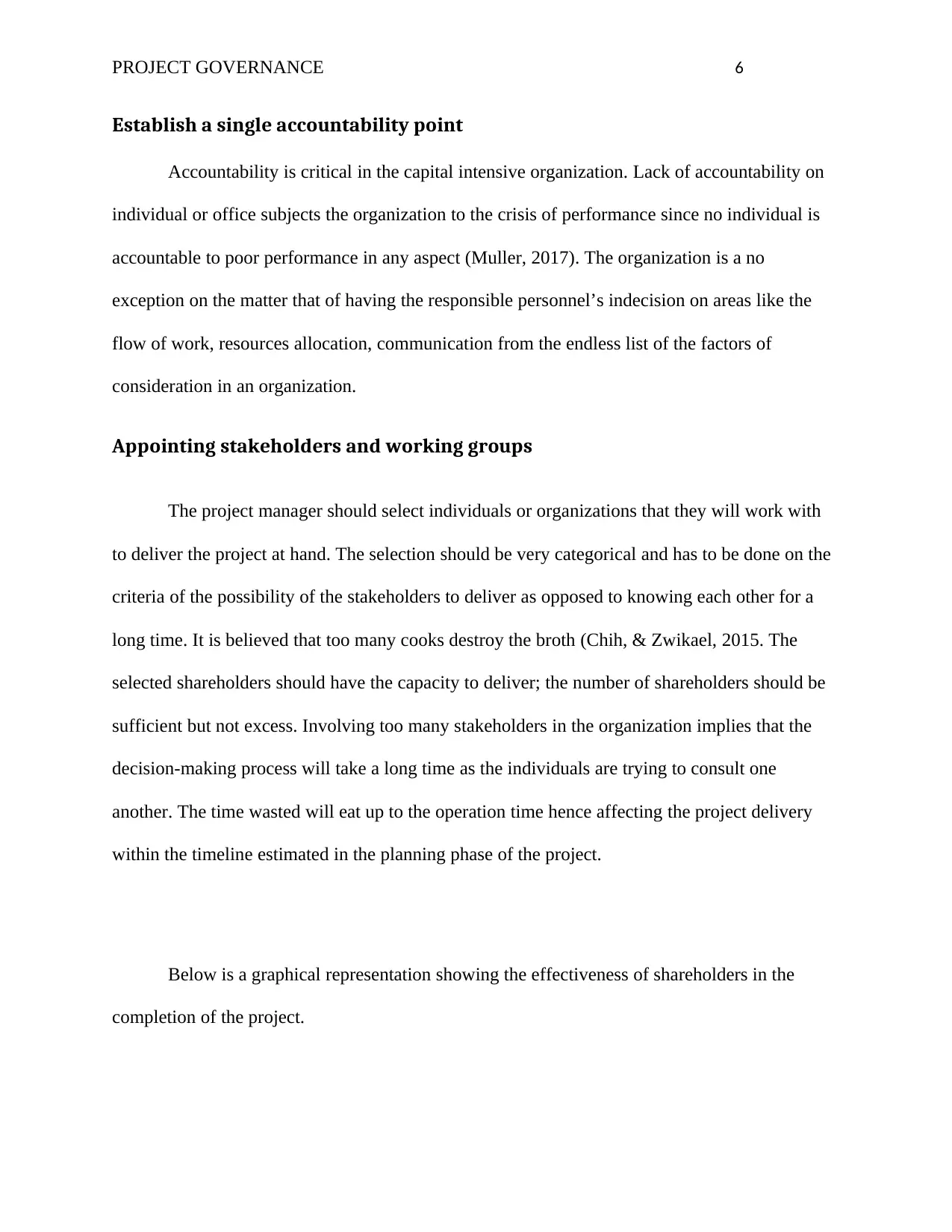
PROJECT GOVERNANCE 6
Establish a single accountability point
Accountability is critical in the capital intensive organization. Lack of accountability on
individual or office subjects the organization to the crisis of performance since no individual is
accountable to poor performance in any aspect (Muller, 2017). The organization is a no
exception on the matter that of having the responsible personnel’s indecision on areas like the
flow of work, resources allocation, communication from the endless list of the factors of
consideration in an organization.
Appointing stakeholders and working groups
The project manager should select individuals or organizations that they will work with
to deliver the project at hand. The selection should be very categorical and has to be done on the
criteria of the possibility of the stakeholders to deliver as opposed to knowing each other for a
long time. It is believed that too many cooks destroy the broth (Chih, & Zwikael, 2015. The
selected shareholders should have the capacity to deliver; the number of shareholders should be
sufficient but not excess. Involving too many stakeholders in the organization implies that the
decision-making process will take a long time as the individuals are trying to consult one
another. The time wasted will eat up to the operation time hence affecting the project delivery
within the timeline estimated in the planning phase of the project.
Below is a graphical representation showing the effectiveness of shareholders in the
completion of the project.
Establish a single accountability point
Accountability is critical in the capital intensive organization. Lack of accountability on
individual or office subjects the organization to the crisis of performance since no individual is
accountable to poor performance in any aspect (Muller, 2017). The organization is a no
exception on the matter that of having the responsible personnel’s indecision on areas like the
flow of work, resources allocation, communication from the endless list of the factors of
consideration in an organization.
Appointing stakeholders and working groups
The project manager should select individuals or organizations that they will work with
to deliver the project at hand. The selection should be very categorical and has to be done on the
criteria of the possibility of the stakeholders to deliver as opposed to knowing each other for a
long time. It is believed that too many cooks destroy the broth (Chih, & Zwikael, 2015. The
selected shareholders should have the capacity to deliver; the number of shareholders should be
sufficient but not excess. Involving too many stakeholders in the organization implies that the
decision-making process will take a long time as the individuals are trying to consult one
another. The time wasted will eat up to the operation time hence affecting the project delivery
within the timeline estimated in the planning phase of the project.
Below is a graphical representation showing the effectiveness of shareholders in the
completion of the project.
⊘ This is a preview!⊘
Do you want full access?
Subscribe today to unlock all pages.

Trusted by 1+ million students worldwide
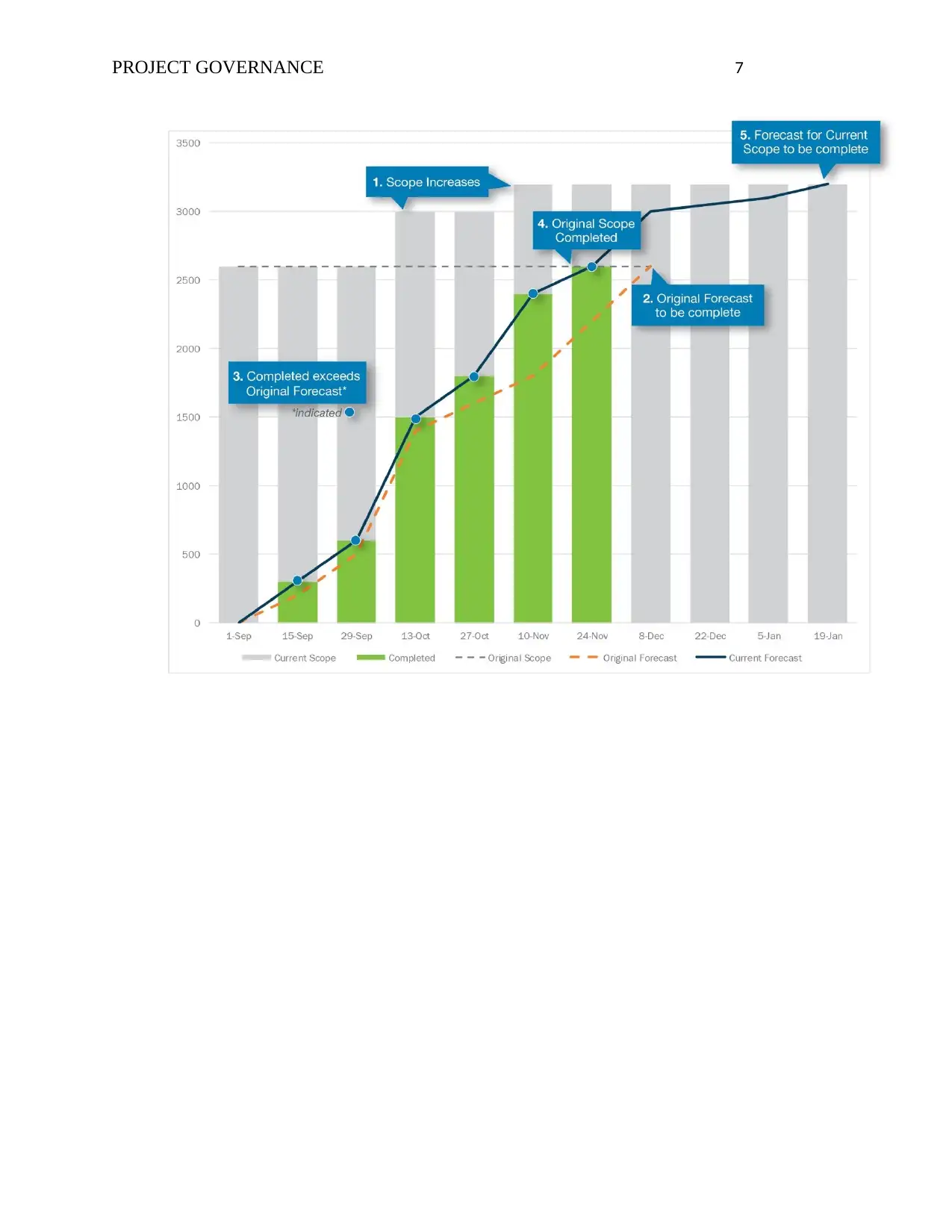
PROJECT GOVERNANCE 7
Paraphrase This Document
Need a fresh take? Get an instant paraphrase of this document with our AI Paraphraser

PROJECT GOVERNANCE 8
Implementing the right system
The systems used in the governance structure should be efficient in existence in the respective
fields. The system, especially in the finance department, should have the highest competence to
handle the financial needs of the organization (Gil, & Pinto, 2016). The weak system would
encourage fund misuse and embezzlement which will consequently subject the organization to
critical financial status hence failure to deliver the project at all or deliver the project at a cost
exceeding the budget of the project.
Regular monitoring
Monitoring of the project progress is essential not only in the significant projects but also
the small ones. Failure to excise regular project monitoring is almost similar to giving up in the
project as if the organization is ready to suffer the loss of the project. People work very.
Differently, some will deliver low-quality services in the process of the project realization due to
lack of the necessary competence in the project. The management has to either coach the
employee on the effective service delivery or even replace him if coaching seems to be a less
efficacious remedy (Musawir, Serra, Zwikael, & Ali, 2017)
Other employees deliver poor quality intentionally to cause loss to the organization on
the ground of malicious and ill motif while other will deliver poor quality as a means of
expression of their dissatisfaction and or anger of the human resource. Monitoring the process
enables the management to identify the factors affecting the employees hence formulating the
strategy for solving the issues affecting the human resource of the construction organization
(Roo, & Porter, 2016).
Implementing the right system
The systems used in the governance structure should be efficient in existence in the respective
fields. The system, especially in the finance department, should have the highest competence to
handle the financial needs of the organization (Gil, & Pinto, 2016). The weak system would
encourage fund misuse and embezzlement which will consequently subject the organization to
critical financial status hence failure to deliver the project at all or deliver the project at a cost
exceeding the budget of the project.
Regular monitoring
Monitoring of the project progress is essential not only in the significant projects but also
the small ones. Failure to excise regular project monitoring is almost similar to giving up in the
project as if the organization is ready to suffer the loss of the project. People work very.
Differently, some will deliver low-quality services in the process of the project realization due to
lack of the necessary competence in the project. The management has to either coach the
employee on the effective service delivery or even replace him if coaching seems to be a less
efficacious remedy (Musawir, Serra, Zwikael, & Ali, 2017)
Other employees deliver poor quality intentionally to cause loss to the organization on
the ground of malicious and ill motif while other will deliver poor quality as a means of
expression of their dissatisfaction and or anger of the human resource. Monitoring the process
enables the management to identify the factors affecting the employees hence formulating the
strategy for solving the issues affecting the human resource of the construction organization
(Roo, & Porter, 2016).
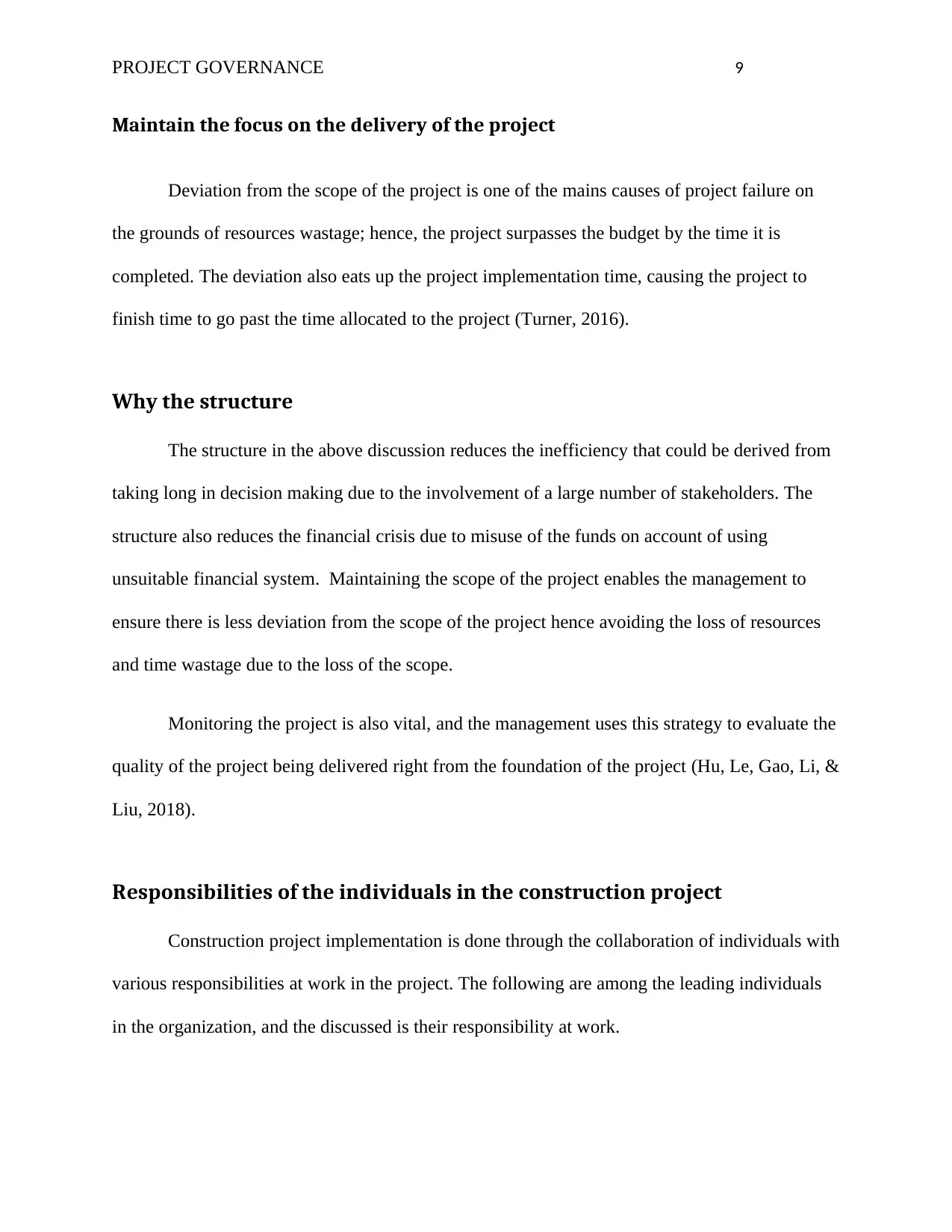
PROJECT GOVERNANCE 9
Maintain the focus on the delivery of the project
Deviation from the scope of the project is one of the mains causes of project failure on
the grounds of resources wastage; hence, the project surpasses the budget by the time it is
completed. The deviation also eats up the project implementation time, causing the project to
finish time to go past the time allocated to the project (Turner, 2016).
Why the structure
The structure in the above discussion reduces the inefficiency that could be derived from
taking long in decision making due to the involvement of a large number of stakeholders. The
structure also reduces the financial crisis due to misuse of the funds on account of using
unsuitable financial system. Maintaining the scope of the project enables the management to
ensure there is less deviation from the scope of the project hence avoiding the loss of resources
and time wastage due to the loss of the scope.
Monitoring the project is also vital, and the management uses this strategy to evaluate the
quality of the project being delivered right from the foundation of the project (Hu, Le, Gao, Li, &
Liu, 2018).
Responsibilities of the individuals in the construction project
Construction project implementation is done through the collaboration of individuals with
various responsibilities at work in the project. The following are among the leading individuals
in the organization, and the discussed is their responsibility at work.
Maintain the focus on the delivery of the project
Deviation from the scope of the project is one of the mains causes of project failure on
the grounds of resources wastage; hence, the project surpasses the budget by the time it is
completed. The deviation also eats up the project implementation time, causing the project to
finish time to go past the time allocated to the project (Turner, 2016).
Why the structure
The structure in the above discussion reduces the inefficiency that could be derived from
taking long in decision making due to the involvement of a large number of stakeholders. The
structure also reduces the financial crisis due to misuse of the funds on account of using
unsuitable financial system. Maintaining the scope of the project enables the management to
ensure there is less deviation from the scope of the project hence avoiding the loss of resources
and time wastage due to the loss of the scope.
Monitoring the project is also vital, and the management uses this strategy to evaluate the
quality of the project being delivered right from the foundation of the project (Hu, Le, Gao, Li, &
Liu, 2018).
Responsibilities of the individuals in the construction project
Construction project implementation is done through the collaboration of individuals with
various responsibilities at work in the project. The following are among the leading individuals
in the organization, and the discussed is their responsibility at work.
⊘ This is a preview!⊘
Do you want full access?
Subscribe today to unlock all pages.

Trusted by 1+ million students worldwide

PROJECT GOVERNANCE 10
The owner or the client or the shareholders
This is the person who owns the project. He is responsible for funding every aspect of the
project, including the materials and the labor supply. The owner may be an individual,
Government, or a group.
Architect
This is the person responsible for the monitoring of the constructions work to ensure the
project is delivered according to the plan of the project in every step (Badewi, 2016).
Facility manager
He is likely the person who is involved in the highest thinking level for the project. His
responsibility is the construction works is to make a project plan on the timeline, quality, and the
budget. In most cases, they work for the client on a lease. He also decides on the systems to be
used and designate inventory monitor.
Health and safety inspector
The health of the human resource must be put at the frontline of the priorities in the
organization. Construction works are risky and hazardous to work at. The health inspector is
responsible for giving health advice and recommending the safety measure the human resource
and the management should employ.
Construction workers
Human resource is one of the most critical aspects of the organization regardless of
whether the construction company is capital intensive or uses artificial intelligence. The human
The owner or the client or the shareholders
This is the person who owns the project. He is responsible for funding every aspect of the
project, including the materials and the labor supply. The owner may be an individual,
Government, or a group.
Architect
This is the person responsible for the monitoring of the constructions work to ensure the
project is delivered according to the plan of the project in every step (Badewi, 2016).
Facility manager
He is likely the person who is involved in the highest thinking level for the project. His
responsibility is the construction works is to make a project plan on the timeline, quality, and the
budget. In most cases, they work for the client on a lease. He also decides on the systems to be
used and designate inventory monitor.
Health and safety inspector
The health of the human resource must be put at the frontline of the priorities in the
organization. Construction works are risky and hazardous to work at. The health inspector is
responsible for giving health advice and recommending the safety measure the human resource
and the management should employ.
Construction workers
Human resource is one of the most critical aspects of the organization regardless of
whether the construction company is capital intensive or uses artificial intelligence. The human
Paraphrase This Document
Need a fresh take? Get an instant paraphrase of this document with our AI Paraphraser
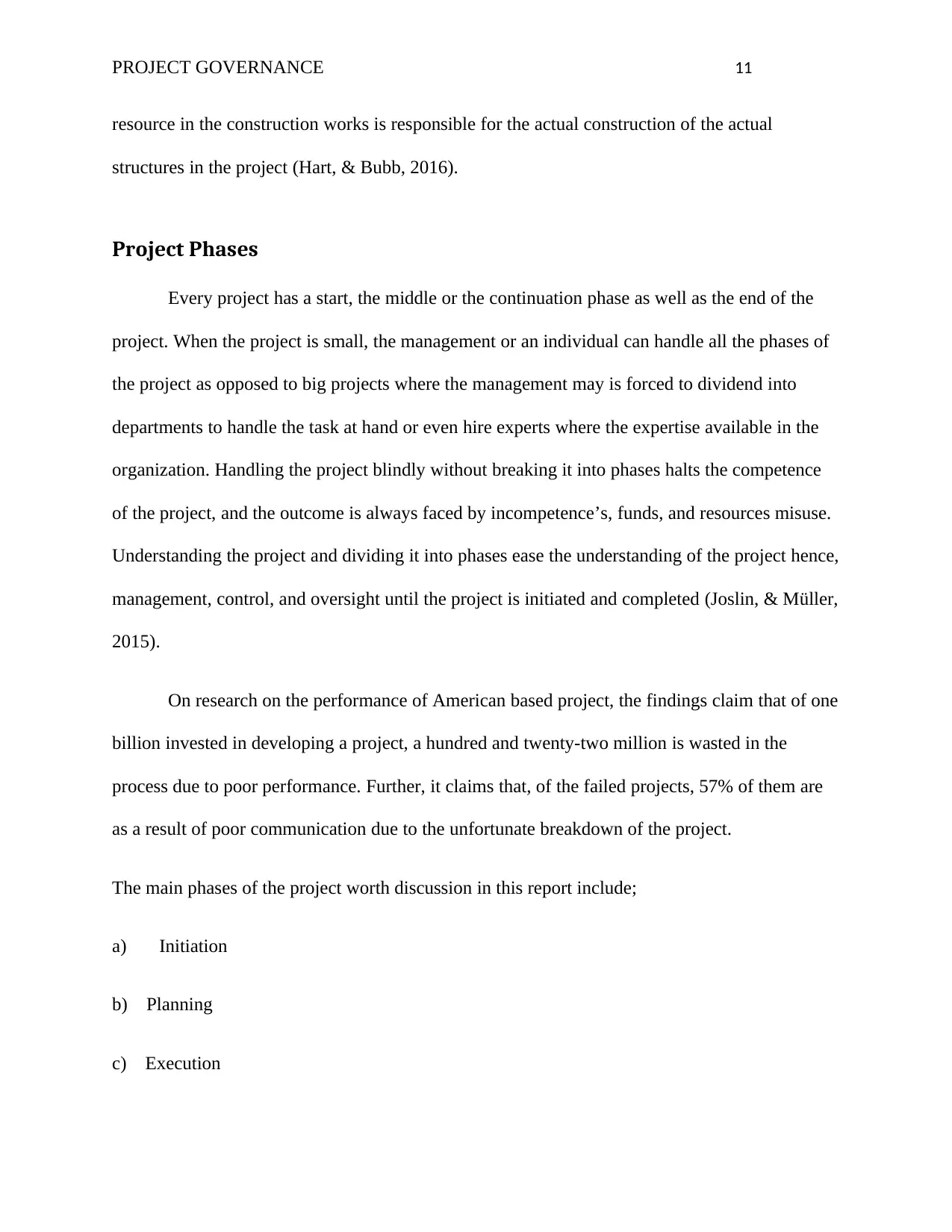
PROJECT GOVERNANCE 11
resource in the construction works is responsible for the actual construction of the actual
structures in the project (Hart, & Bubb, 2016).
Project Phases
Every project has a start, the middle or the continuation phase as well as the end of the
project. When the project is small, the management or an individual can handle all the phases of
the project as opposed to big projects where the management may is forced to dividend into
departments to handle the task at hand or even hire experts where the expertise available in the
organization. Handling the project blindly without breaking it into phases halts the competence
of the project, and the outcome is always faced by incompetence’s, funds, and resources misuse.
Understanding the project and dividing it into phases ease the understanding of the project hence,
management, control, and oversight until the project is initiated and completed (Joslin, & Müller,
2015).
On research on the performance of American based project, the findings claim that of one
billion invested in developing a project, a hundred and twenty-two million is wasted in the
process due to poor performance. Further, it claims that, of the failed projects, 57% of them are
as a result of poor communication due to the unfortunate breakdown of the project.
The main phases of the project worth discussion in this report include;
a) Initiation
b) Planning
c) Execution
resource in the construction works is responsible for the actual construction of the actual
structures in the project (Hart, & Bubb, 2016).
Project Phases
Every project has a start, the middle or the continuation phase as well as the end of the
project. When the project is small, the management or an individual can handle all the phases of
the project as opposed to big projects where the management may is forced to dividend into
departments to handle the task at hand or even hire experts where the expertise available in the
organization. Handling the project blindly without breaking it into phases halts the competence
of the project, and the outcome is always faced by incompetence’s, funds, and resources misuse.
Understanding the project and dividing it into phases ease the understanding of the project hence,
management, control, and oversight until the project is initiated and completed (Joslin, & Müller,
2015).
On research on the performance of American based project, the findings claim that of one
billion invested in developing a project, a hundred and twenty-two million is wasted in the
process due to poor performance. Further, it claims that, of the failed projects, 57% of them are
as a result of poor communication due to the unfortunate breakdown of the project.
The main phases of the project worth discussion in this report include;
a) Initiation
b) Planning
c) Execution
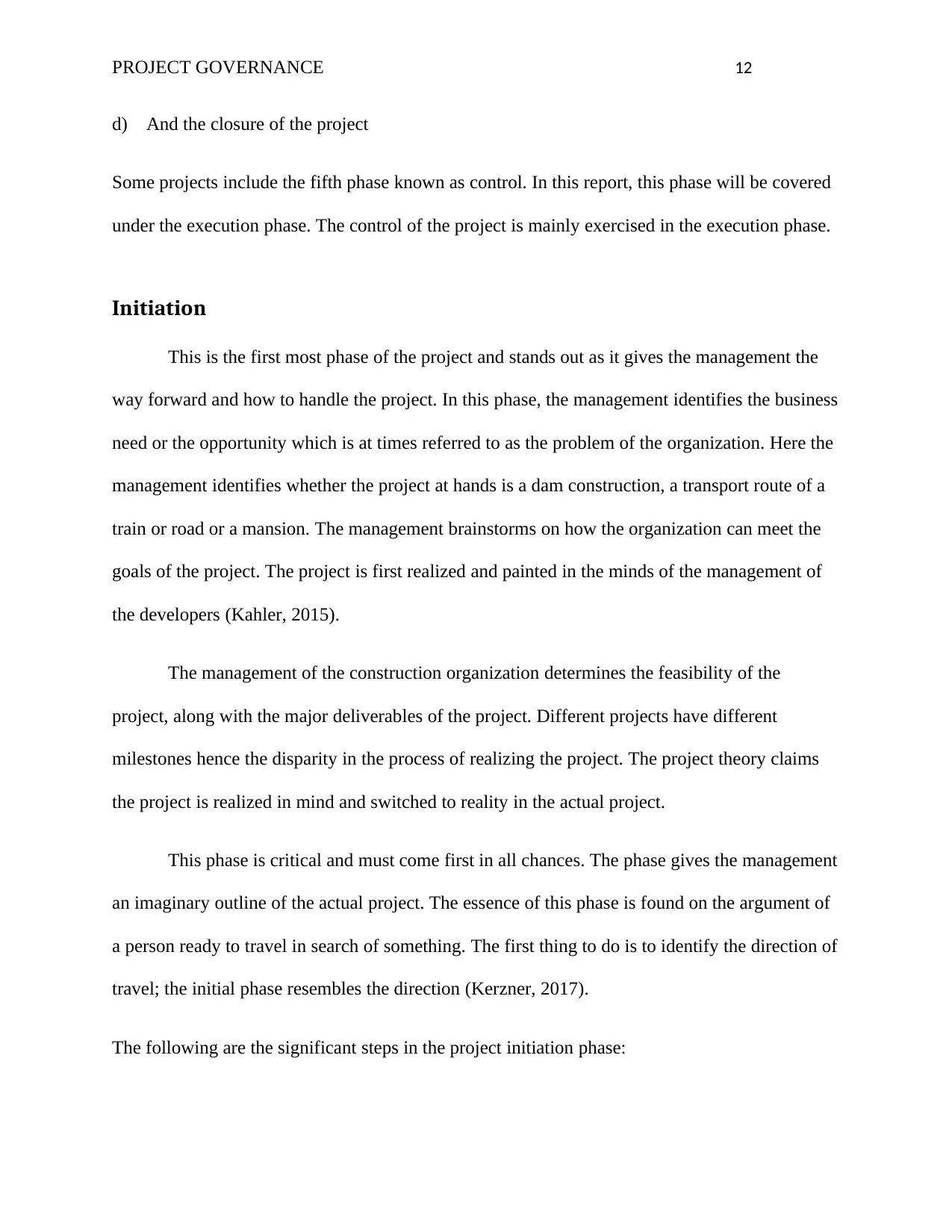
PROJECT GOVERNANCE 12
d) And the closure of the project
Some projects include the fifth phase known as control. In this report, this phase will be covered
under the execution phase. The control of the project is mainly exercised in the execution phase.
Initiation
This is the first most phase of the project and stands out as it gives the management the
way forward and how to handle the project. In this phase, the management identifies the business
need or the opportunity which is at times referred to as the problem of the organization. Here the
management identifies whether the project at hands is a dam construction, a transport route of a
train or road or a mansion. The management brainstorms on how the organization can meet the
goals of the project. The project is first realized and painted in the minds of the management of
the developers (Kahler, 2015).
The management of the construction organization determines the feasibility of the
project, along with the major deliverables of the project. Different projects have different
milestones hence the disparity in the process of realizing the project. The project theory claims
the project is realized in mind and switched to reality in the actual project.
This phase is critical and must come first in all chances. The phase gives the management
an imaginary outline of the actual project. The essence of this phase is found on the argument of
a person ready to travel in search of something. The first thing to do is to identify the direction of
travel; the initial phase resembles the direction (Kerzner, 2017).
The following are the significant steps in the project initiation phase:
d) And the closure of the project
Some projects include the fifth phase known as control. In this report, this phase will be covered
under the execution phase. The control of the project is mainly exercised in the execution phase.
Initiation
This is the first most phase of the project and stands out as it gives the management the
way forward and how to handle the project. In this phase, the management identifies the business
need or the opportunity which is at times referred to as the problem of the organization. Here the
management identifies whether the project at hands is a dam construction, a transport route of a
train or road or a mansion. The management brainstorms on how the organization can meet the
goals of the project. The project is first realized and painted in the minds of the management of
the developers (Kahler, 2015).
The management of the construction organization determines the feasibility of the
project, along with the major deliverables of the project. Different projects have different
milestones hence the disparity in the process of realizing the project. The project theory claims
the project is realized in mind and switched to reality in the actual project.
This phase is critical and must come first in all chances. The phase gives the management
an imaginary outline of the actual project. The essence of this phase is found on the argument of
a person ready to travel in search of something. The first thing to do is to identify the direction of
travel; the initial phase resembles the direction (Kerzner, 2017).
The following are the significant steps in the project initiation phase:
⊘ This is a preview!⊘
Do you want full access?
Subscribe today to unlock all pages.

Trusted by 1+ million students worldwide
1 out of 24
Related Documents
Your All-in-One AI-Powered Toolkit for Academic Success.
+13062052269
info@desklib.com
Available 24*7 on WhatsApp / Email
![[object Object]](/_next/static/media/star-bottom.7253800d.svg)
Unlock your academic potential
Copyright © 2020–2025 A2Z Services. All Rights Reserved. Developed and managed by ZUCOL.





